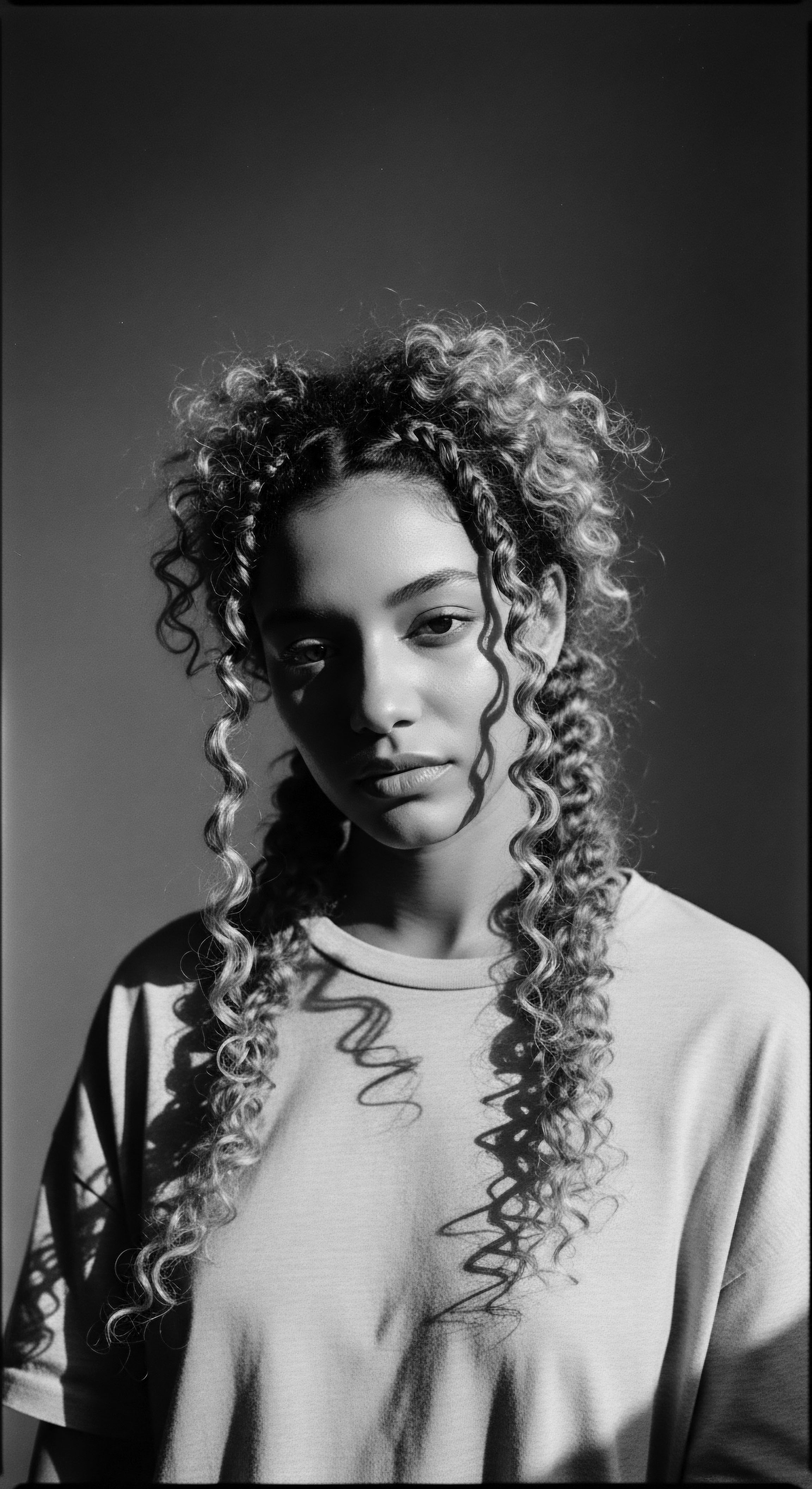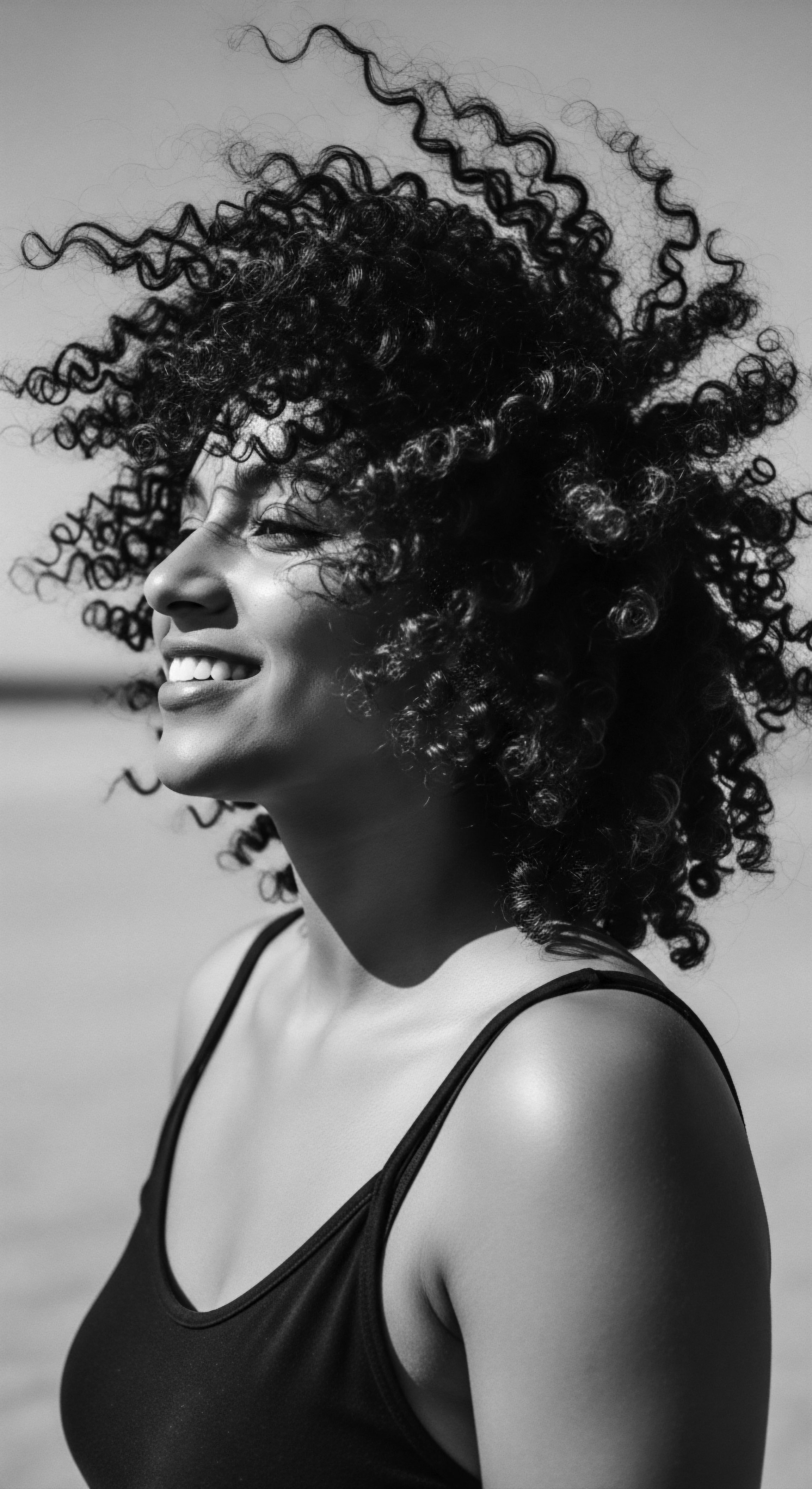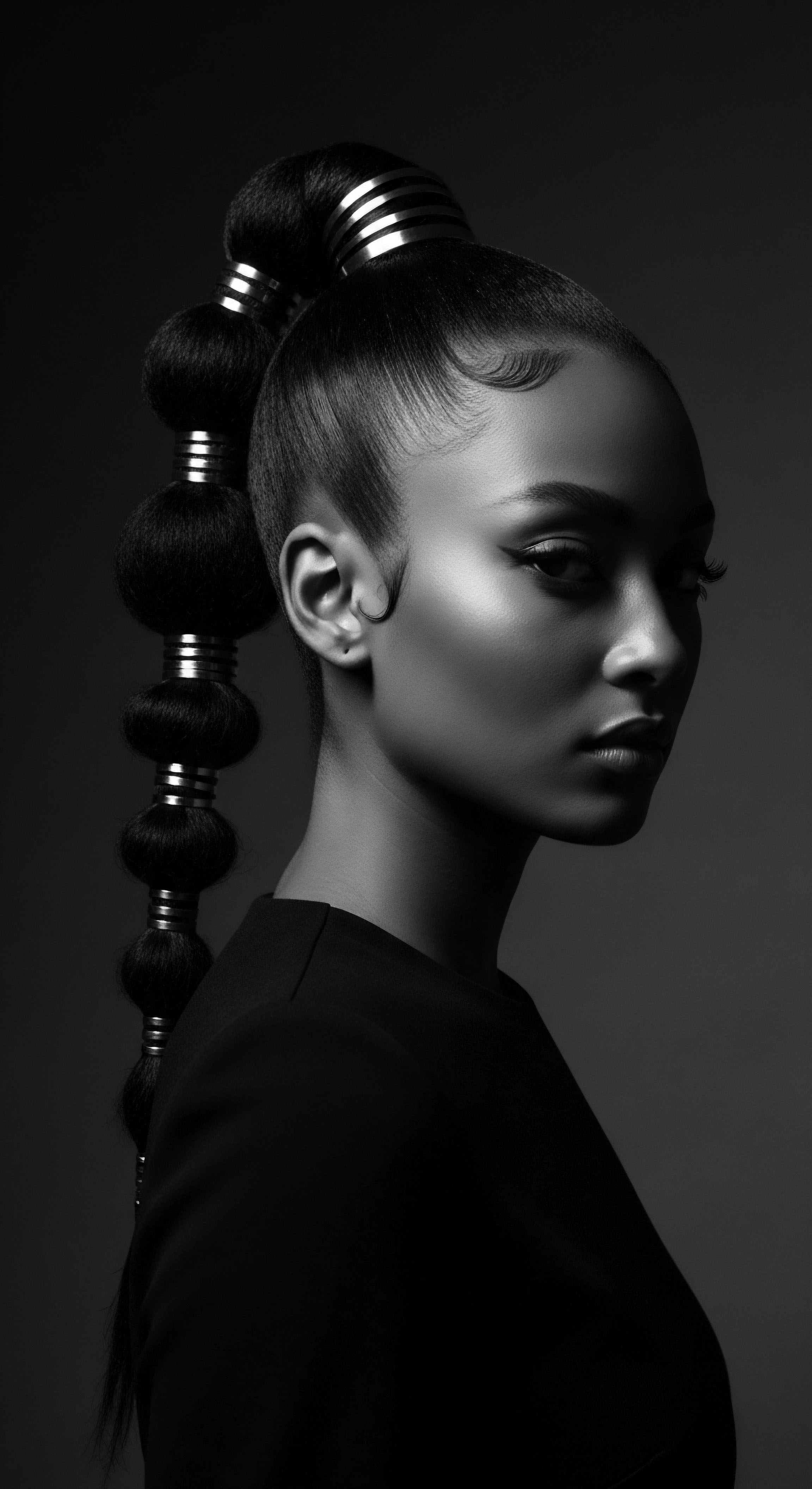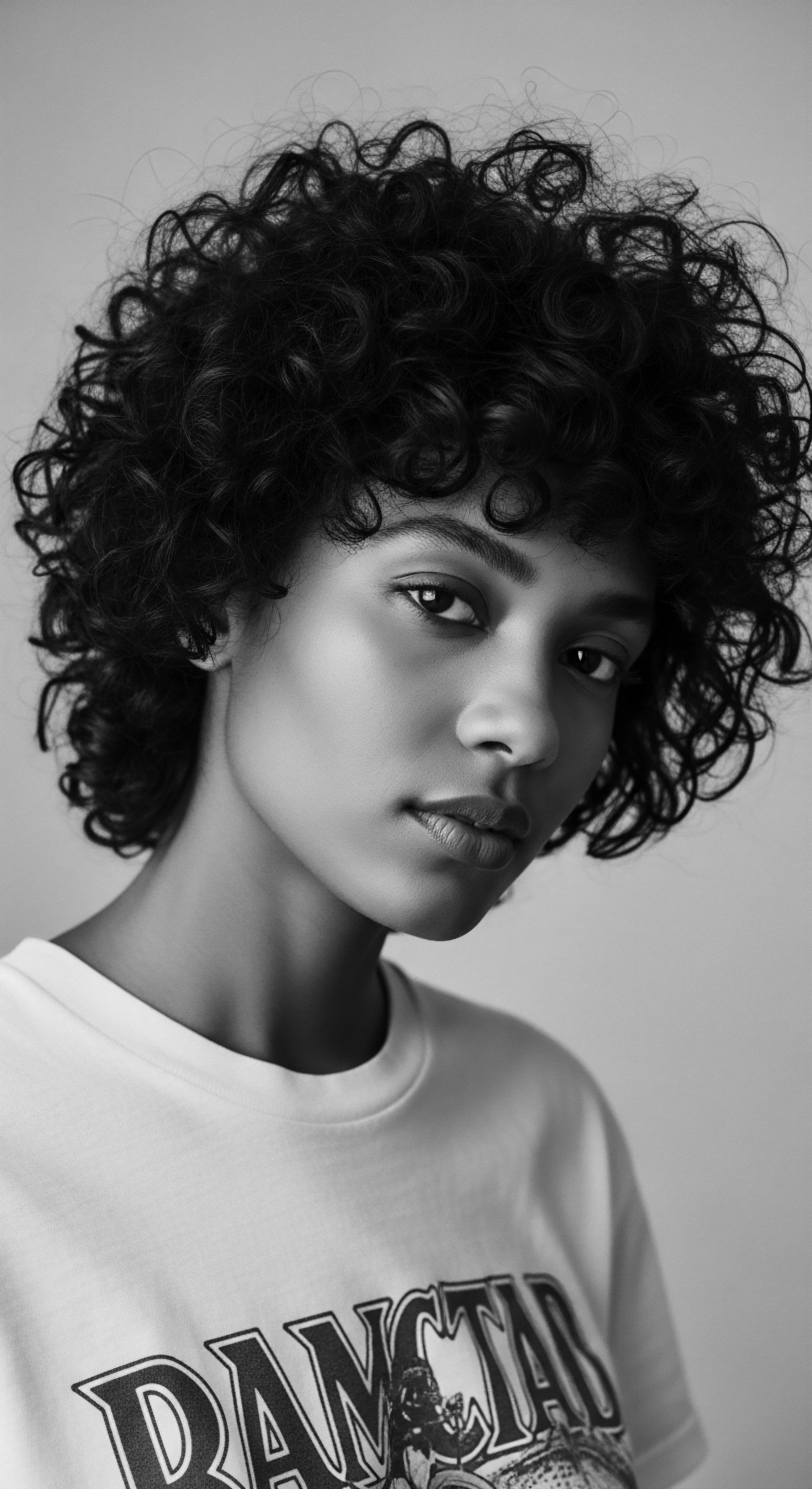
Roots
The story of textured hair, with its wondrous coils and intricate formations, is a deep, resonant chord within the grand symphony of human heritage. It is a chronicle whispered through generations, etched into the very strands of ancestry, and brought to life through practices passed down across continents and centuries. For those whose hair springs forth in glorious spirals and tight z-patterns, the engagement with oils is not a fleeting trend; it is a continuation of a profound, enduring dialogue between hair and its ancestral keepers. We speak of coils that defy simple categorization, each bend and curve a testament to a unique biological blueprint, yet universally understood within the heart of Black and mixed-race communities.
Consider the intricate dance of oil upon a strand, a dance understood intuitively by countless hands long before the advent of modern chemistry. These ancient understandings, rooted in necessity and observation, form the very bedrock of our contemporary knowledge. Our textured hair, with its distinct anatomical signature, often presents a morphology that resists moisture’s embrace, a characteristic that, perhaps, spurred early innovators toward the protective qualities of natural oils. Research reveals that African hair, despite its inherent lipid content, can also be prone to dryness due to its coiled structure, which creates points of weakness and impedance for natural sebum to travel down the shaft.
(Mahlangu & Ngcobo, 2022, p. 715) This foundational understanding, gleaned through centuries of lived experience, guided ancestral communities in their selection and application of botanicals.

What Makes Textured Hair Distinct
To truly grasp how oils support textured hair, we must first appreciate the inherent architecture of these magnificent coils. Unlike straighter hair types, textured hair fibers often exhibit an elliptical cross-sectional shape, a deviation from the more circular forms. This flattened, ribbon-like structure, combined with the distinct angle at which the hair shaft emerges from the scalp, dictates the hair’s tendency to coil upon itself. The very act of coiling, while beautiful, creates numerous points of stress along the strand, making it susceptible to breakage if not tended with mindful hands.
Moreover, the cuticle layers—the outermost protective scales of the hair strand—do not lie as flat on textured hair as they do on straight hair. This slightly raised posture, while contributing to the hair’s characteristic volume, can also permit moisture to escape more readily. This intrinsic quality underlines why the consistent application of external emollients, particularly oils, became a cornerstone of ancestral hair care practices. It was an intuitive response to a biological reality.

Ancestral Wisdom and The Hair’s Architecture
Long before electron microscopes laid bare the cellular secrets of a hair strand, our foremothers and forefathers possessed an uncanny wisdom concerning their hair’s needs. Their understanding, forged through observation and experimentation, recognized the dry disposition of coiled hair and sought solutions from the natural world around them. This knowledge was not theoretical; it was practical, a lived science passed from elder to child, each generation adding to the collective wisdom.
The rich history of hair oiling, in fact, spans centuries and is deeply rooted in various global cultures, including those of West Africa. (Cécred, 2025)
The very lexicon surrounding textured hair care, both ancient and contemporary, echoes this ancestral recognition. Words for hair types, styling techniques, and ingredients were woven into daily parlance, reflecting a society deeply attuned to the nuances of their crown. Terms such as Kinky, Coily, and Nappy, while having faced historical weaponization, originally described distinct textures with precision, allowing for tailored care within communities.
The very architecture of textured hair, with its unique coiling and cuticle structure, predisposed ancestral communities to seek external emollients for its care.

A Historical Glimpse Oils in Ancient Practices
Across ancient African civilizations, natural oils and plant-based butters were not merely cosmetic aids; they were vital for survival and cultural expression. The dry, often harsh climates of various African regions necessitated robust protective measures for skin and hair. Shea butter, for instance, a gift from the Vitellaria paradoxa tree, holds centuries of use, cherished by women in West African countries for its moisturizing and protective qualities against sun, wind, and dust. (Ciafe, 2023; Africa Imports, 2023)
Consider the Himba people of Namibia, whose distinctive red ochre paste, Otjize, applied to their hair and skin, comprises butterfat and ochre. This practice, laden with cultural symbolism, offers protection from the harsh sun and insects while connecting them to their land and ancestors. (Bebrų Kosmetika, 2024) These are not isolated instances; countless examples across the continent underscore the deep historical connection between natural oils and textured hair care, a connection born of acute observation and communal need.
| Community/Region West Africa (General) |
| Traditional Oil/Butter Used Shea Butter, Palm Oil |
| Purpose and Heritage Link Moisture retention, sun protection, skin and hair nourishment; deeply integrated into daily life and rituals. (Cécred, 2025; Ciafe, 2023) |
| Community/Region Himba Tribe (Namibia) |
| Traditional Oil/Butter Used Butterfat (in Otjize paste) |
| Purpose and Heritage Link Sun and insect protection, cultural identity, ancestral connection; a symbolic and practical application. (Bebrų Kosmetika, 2024) |
| Community/Region Ancient Egypt |
| Traditional Oil/Butter Used Almond Oil, Castor Oil |
| Purpose and Heritage Link Hair nourishment, general beauty regimens; Cleopatra herself was said to use castor oil. (Etre Vous, 2022; Ciafe, 2023) |
| Community/Region Morocco |
| Traditional Oil/Butter Used Argan Oil |
| Purpose and Heritage Link Hydration, anti-aging, promoting youthful hair and skin; traditionally used by Moroccan women. (Africa Imports, 2025) |
| Community/Region These ancestral practices reveal a shared wisdom concerning the protective and nourishing qualities of oils for hair, particularly within diverse African heritage contexts. |

Ritual
The application of oils to textured hair has always transcended mere biological need. It blossoms into ritual, a tender thread connecting generations, a silent language spoken through hands and hair. This ritual, whether a communal gathering or a solitary act of self-care, embodies ancestral wisdom.
It speaks of a time when hair was a living archive, conveying social status, marital standing, and even messages of survival during periods of immense duress. The careful oiling of coils was an affirmation of identity, a gesture of resistance against oppressive forces seeking to diminish the inherent beauty of Black hair.
In West African traditions, hair was, and remains, a potent symbol of identity and heritage. (Butter & Sage, 2025) The act of oiling was often intertwined with elaborate styling techniques, such as braiding and twisting, which served not only aesthetic purposes but also as protective measures. These styles, often taking hours or even days to complete, fostered community and bonding, turning hair care into a shared experience, a living repository of cultural memory. (Livara Natural Organics, 2023)

What Does Hair Oiling Do for Coils?
The efficacy of oils on textured hair stems from their ability to provide both immediate and sustained support to the hair shaft and scalp. Coiled hair, with its numerous bends, experiences challenges in sebum distribution from the scalp down the length of the strand. Oils act as a crucial external supplement, mimicking and enhancing the scalp’s natural lipid barrier.
A primary function of oils lies in their capacity to Seal in Moisture. After cleansing and hydrating the hair with water-based products, oils form a protective layer around the hair cuticle. This occlusive barrier minimizes water evaporation from the hair shaft, thus maintaining its hydration levels for longer.
This is particularly significant for textured hair, which is prone to dryness and breakage. (Etre Vous, 2022)
Beyond sealing, certain oils possess the molecular structure to penetrate the hair shaft itself. Coconut oil, for example, with its smaller molecular size, can move beyond the cuticle and into the cortex, helping to reduce protein loss during washing and comb-induced damage. (Etre Vous, 2022) This internal fortification, coupled with external conditioning, works synergistically to improve the hair’s elasticity and reduce the likelihood of mechanical breakage, a common concern for textured strands.
The consistent application of oils to textured hair serves as a profound ritual, mirroring ancestral practices that prioritized moisture retention and protection for coils.

Traditional Preparations and Communal Practices
The ritual of oiling often involved specific preparations and communal practices, each imbued with cultural meaning. In many African communities, the selection of particular oils was not arbitrary. It depended on local flora, climate, and the specific needs perceived.
Shea butter, a prominent example, was meticulously prepared through traditional methods involving harvesting, drying, crushing, and boiling the nuts, a labor-intensive process that transformed it into a creamy, nourishing butter. (Ciafe, 2023; Discovering the Origins of Shea Butter, 2024)
These methods were often passed down through generations, ensuring the continuity of the practice. The preparation itself became a communal act, women gathering to process shea nuts, sharing stories, songs, and laughter, solidifying bonds within the community. This communal aspect extended to the application of oils, with elders often massaging oil into the scalps of younger family members, an act of both care and bonding. (Cécred, 2025)
Historically, practices included:
- Scalp Anointing ❉ Oils, sometimes infused with herbs like rosemary or sage, were massaged into the scalp. This was considered not only physical nourishment but also a spiritual blessing, believed to protect the spirit and crown. (Substack, 2025)
- Hair Dressing for Protective Styles ❉ Oils and butters were essential for preparing hair for braids, twists, and cornrows, providing slip, moisture, and shine, and ensuring the longevity of these protective styles. (Livara Natural Organics, 2023; Bebrų Kosmetika, 2024)
- Post-Cleansing Sealing ❉ After using traditional cleansers like African black soap, oils were applied to seal in the moisture, preventing the hair from drying out in harsh climates. (Africa Imports, 2023)
The wisdom embedded in these traditional practices finds echoes in modern scientific understanding. For example, massaging the scalp, a common component of ancestral oiling rituals, is known to boost blood flow, ensuring follicles receive proper nutrition. (Etre Vous, 2022)

A Bridge Across Time The Jojoba Story
The story of jojoba oil provides a fascinating bridge between ancient wisdom and contemporary practice, particularly within the Black beauty tradition. While native to the arid deserts of North America, jojoba oil’s properties—especially its striking similarity to human sebum—made it a natural fit for textured hair care. (BeautyMatter, 2025) In the 1970s, as the “Black is Beautiful” movement gained momentum, a conscious return to natural hairstyles occurred.
This era saw Black consumers and entrepreneurs actively embrace jojoba oil, valuing its ability to address dryness, breakage, and scalp concerns common to textured hair. (BeautyMatter, 2025)
Choosing natural oils like jojoba during this period represented a deliberate act of self-determination, a alignment with cultural authenticity, and a gentle push against Eurocentric beauty ideals that had long dismissed textured hair. (BeautyMatter, 2025) This historical moment underscored the active role of oils in affirming heritage and identity, transforming a simple ingredient into a symbol of pride.

Relay
The wisdom concerning oils and coiled hair continues its journey, a relay race of knowledge passed from past to present, ever adapting, ever relevant. This ongoing transmission reveals itself in the deepening scientific understanding that validates long-held ancestral practices, and in the conscious choices made by individuals seeking to connect with their hair’s lineage. The dialogue between the tangible benefits of oils and the intangible connection to heritage forms a rich tapestry of care and cultural significance.
Modern scientific inquiry has, in many instances, provided compelling explanations for the efficacy of hair oiling, lending empirical weight to the intuitive practices of our forebears. Textured hair, by its very nature, often presents as dry despite its internal lipid content. (Preprints.org, 2024; Mahlangu & Ngcobo, 2022) This apparent paradox stems from the hair’s unique structure, where the helical shape creates points of weakness and uneven cuticle distribution, allowing for more significant moisture loss. Oils, therefore, act as essential exogenous emollients, complementing the hair’s natural defenses.

How Oils Fortify the Hair’s Structure
At a microscopic level, oils function by creating a protective layer on the hair’s surface, acting as a hydrophobic barrier. This barrier repels excess water, thereby minimizing the swelling and shrinking of the hair shaft during wetting and drying cycles. Such cycles can stress the hair’s delicate protein structure, particularly at the curves of a coil. By reducing this stress, oils contribute to the hair’s overall resilience and longevity.
Moreover, specific oils with smaller molecular weights, such as coconut oil, have demonstrated the capacity to penetrate beyond the outer cuticle layer into the hair’s cortex. (Etre Vous, 2022) Once inside, these lipids can interact with the keratin proteins, contributing to the hair’s internal strength and flexibility. A study on the physicochemical properties of textured hair noted that fibrillar structures (keratins) are heavily coated with biological material, presumably lipids, suggesting an inherent need for lipid support within the coil’s architecture.
(Mahlangu & Ngcobo, 2022, p. 715) This scientific observation aligns beautifully with the ancestral practice of generously oiling textured strands.

Do All Oils Support Coils Uniformly?
The effectiveness of oils on textured hair is not a monolithic concept. Different oils possess varied compositions of fatty acids, vitamins, and antioxidants, influencing their interaction with the hair.
- Coconut Oil ❉ Known for its ability to penetrate the hair shaft, reducing protein loss due to its lauric acid content. (Etre Vous, 2022)
- Olive Oil ❉ Rich in monounsaturated fatty acids, it offers excellent conditioning and smoothing properties, assisting in reducing frizz. (BLAM UK CIC, 2022)
- Castor Oil ❉ A viscous oil, historically used in various African beauty regimens, particularly noted for its potential to support hair density and scalp health due to its ricinoleic acid. (Etre Vous, 2022; Substack, 2025)
- Shea Butter ❉ A heavier butter, it provides deep conditioning and protection, forming a substantial barrier against moisture loss, particularly beneficial for very dry or coarse coils. (Ciafe, 2023; Africa Imports, 2023)
A recent study exploring vegetable oil penetration in textured hair indicated that while popular oils like coconut, avocado, and argan do penetrate the fibers, their impact on hair strength varies based on hair type and whether the hair is chemically treated. (Cosmetics Design, 2025) This research emphasizes that textured hair’s unique cortical arrangement leads to uneven oil penetration, influencing consistent mechanical effects. (Cosmetics Design, 2025) This finding underscores the ongoing need for nuanced understanding and personalized application, building upon foundational heritage practices.
| Oil Type Coconut Oil |
| Key Properties Saturated fatty acids (lauric acid), small molecular size for penetration. |
| Relevance to Textured Hair Heritage Widely used in historical care across various regions for deep conditioning and protein retention. (Etre Vous, 2022) |
| Oil Type Castor Oil |
| Key Properties Ricinoleic acid, high viscosity. |
| Relevance to Textured Hair Heritage Historically valued for scalp health and believed to support density; prominent in African and diasporic practices. (Etre Vous, 2022; Substack, 2025) |
| Oil Type Shea Butter |
| Key Properties Vitamins A & E, rich fatty acid profile, melting point close to body temperature. |
| Relevance to Textured Hair Heritage A primary ingredient in West African ancestral hair care, known for deep moisture and protection; "women's gold." (Ciafe, 2023; Discovering the Origins of Shea Butter, 2024) |
| Oil Type Jojoba Oil |
| Key Properties Liquid wax ester, similar to human sebum. |
| Relevance to Textured Hair Heritage Became significant during the "Black is Beautiful" movement as a natural, non-greasy emollient that resonated with traditional care. (BeautyMatter, 2025) |
| Oil Type Understanding these diverse properties allows for a more informed approach to oil selection, honoring the nuanced needs of textured hair as understood through generations of care. |

Holistic Care in Ancestral Contexts
The historical use of oils was rarely isolated; it was part of a holistic approach to wellbeing, where hair care was inseparable from overall health and spiritual connection. Ancient African hair rituals often involved a deep reverence for the hair, viewing it as a link to ancestry, spirituality, and identity. (Substack, 2025) Oils, applied with intention and often accompanied by songs or prayers, were believed to seal the crown chakra and protect the spirit. (Substack, 2025)
This ancestral philosophy stands in stark contrast to the modern compartmentalization of beauty from wellness. The emphasis on gentle manipulation, protective styling, and consistent nourishment, all supported by oils, reveals a wisdom that understood the interconnectedness of physical health, spiritual peace, and external presentation. The enduring legacy of this comprehensive approach speaks to the profound understanding our ancestors held regarding the intricate needs of textured hair.
The connection between hair oiling and ancestral practices is not merely anecdotal; it is substantiated by a consistent historical record. During the period of enslavement, despite horrific attempts to strip enslaved Africans of their identity, hair care practices, including the use of available natural oils like shea butter and coconut oil, persisted as acts of cultural expression and resilience. (University of Salford, 2024; Livara Natural Organics, 2023) This continuity, in the face of profound adversity, underscores the deeply ingrained significance of oils in supporting textured hair, both physically and culturally.

Reflection
As we close this contemplation on oils and textured hair’s natural coils, we find ourselves standing at a crossroad where ancestral echoes meet the murmurs of modern science. The essence of Roothea’s ‘Soul of a Strand’ ethos finds its purest expression in this enduring narrative ❉ the care of textured hair is a living, breathing archive, a testament to resilience, beauty, and unwavering connection to heritage. Oils, humble yet potent, have been steadfast companions on this journey, their presence in hair care rituals a thread of continuity spanning epochs and geographies.
The spiral of a coil, a biological wonder, has always carried stories. It is a symbol of identity, a canvas for self-expression, and a repository of collective memory. From the meticulous application of shea butter in West African villages to the careful anointing of tresses in diasporic homes, oils have provided the nourishment, protection, and sheen that allow these stories to be told. The knowledge was never confined to scientific texts; it resided in the hands that braided, the whispers that taught, and the traditions that endured.
Our understanding of oils’ role deepens with each passing generation, yet the fundamental wisdom remains tethered to its origins. The ancestors, with their acute observation of nature, perceived what science now confirms ❉ that textured hair, with its unique structure, benefits immeasurably from the lubrication and sealing properties that oils afford. The legacy we inherit compels us to approach hair care not as a chore, but as a sacred dialogue with our past, a deliberate act of honoring the strands that carry the very spirit of our lineage.
This heritage is not static; it lives and breathes, continually shaped by individual choices and communal practices. The choice to utilize oils, to nurture textured hair with care rooted in ancestral practices, is a conscious act of reclaiming and celebrating one’s identity. It is a recognition that the beauty of our coils holds layers of meaning, a heritage whispered in every supple strand, strengthened by the very oils that have sustained them through time.

References
- Mahlangu, K. & Ngcobo, P. (2022). Physicochemical Properties of Textured Hair. Journal of Cosmetic Science, 73 (5), 715-728.
- Cécred. (2025, April 15). Understanding Hair Oiling ❉ History, Benefits & More. Retrieved from
- Ciafe. (2023, January 31). Shea Butter – Explainer. Retrieved from
- BeautyMatter. (2025, February 4). The Untold Story of Jojoba Oil in Black Beauty. Retrieved from
- Butter & Sage. (2025, February 23). Scalp and Hair Oiling Across Cultures ❉ A Global Tradition. Retrieved from
- Livara Natural Organics. (2023, February 7). Black History Month ❉ The Rich History of Our African Hair. Retrieved from
- Etre Vous. (2022, August 24). Here’s why hair oiling is the ancient ritual worth adopting. Retrieved from
- Bebrų Kosmetika. (2024, August 23). The Power of Hair in African Folklore ❉ Rituals and Traditions. Retrieved from
- Africa Imports. (2023). Traditional African Secrets For Long And Healthy Hair. Retrieved from
- Discovering the Origins of Shea Butter. (2024, February 10). A Journey to the Heart of Africa. Retrieved from
- University of Salford Students’ Union. (2024, October 29). The Remarkable History Behind Black Hairstyles. Retrieved from
- Preprints.org. (2024, July 15). The Genomic Variation in Textured Hair ❉ Implications in Developing a Holistic Hair Care Routine. Retrieved from
- Substack. (2025, May 4). Ancestral Hair Rituals to Nourish Your Hair and Soul. Retrieved from
- Cosmetics Design. (2025, January 8). Study reveals differences in vegetable oil penetration between textured and straight hair types. Retrieved from
- Africa Imports. (2025, January 16). African Beauty and Skincare ❉ A Deep Dive into History, Traditions, and Natural Ingredients. Retrieved from
- BLAM UK CIC. (2022, September 15). The history of Black Hair. Retrieved from
